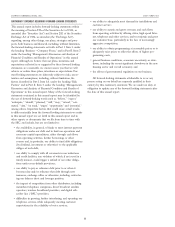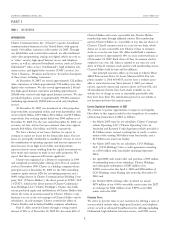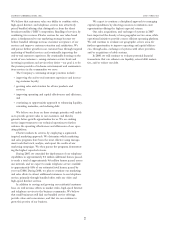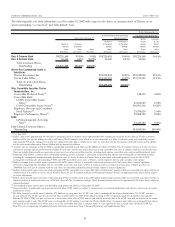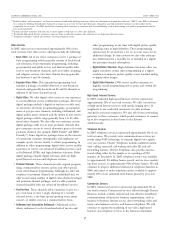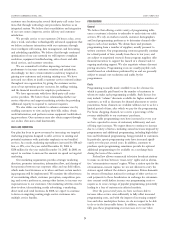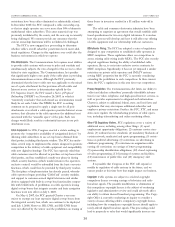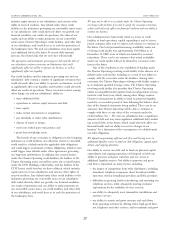Charter 2007 Annual Report Download - page 20
Download and view the complete annual report
Please find page 20 of the 2007 Charter annual report below. You can navigate through the pages in the report by either clicking on the pages listed below, or by using the keyword search tool below to find specific information within the annual report.
customer care locations plus several third-party call center loca-
tions that through technology and procedures function as an
integrated system. We believe that consolidation and integration
of our care centers improves service delivery and customer
satisfaction.
We provide service to our customers 24 hours a day, seven
days a week, and utilize technologically advanced equipment that
we believe enhances interactions with our customers through
more intelligent call routing, data management, and forecasting
and scheduling capabilities. We believe that through continued
optimization of our care network we will improve complaint
resolution, equipment troubleshooting, sales of new and addi-
tional services, and customer retention.
We are committed to further improving customer care
performance to increase customer retention and satisfaction.
Accordingly, we have certain initiatives underway targeted at
gaining new customers and retaining existing ones. We have
increased our efforts to instill a customer service oriented culture
throughout our organization, by giving the customer service
areas of our operations greater resources for staffing, training,
and the financial incentives for employee performance.
We have agreements with three third-party call center
service providers. We believe these relationships further our
service objectives and support marketing activities by providing
additional capacity to respond to customer inquiries.
We also utilize our website to enhance customer care by
enabling customers to view and pay their bills online, obtain
useful information, and perform various equipment troubleshoot-
ing procedures. Our customers may also obtain support through
our on-line chat and e-mail functionality.
SALES AND MARKETING
Our plan has been to grow revenues by increasing our targeted
marketing programs designed to offer services to existing and
potential customers with particular emphasis on our bundled
services. As a result, marketing expenditures increased by $58 mil-
lion, or 32%, over the year ended December 31, 2006 to
$238 million for the year ended December 31, 2007. In 2008, we
expect to continue to increase the amount we spend on targeted
marketing.
Our marketing organization provides strategic marketing
direction, promotes interaction, information flow, and sharing of
best practices between our corporate office and our field offices,
which make local decisions as to when and how certain market-
ing programs will be implemented. We monitor the effectiveness
of our marketing efforts, customer perception, competition, pric-
ing, and service preferences, among other factors, to increase our
responsiveness to our customers. Our marketing activities involve
door-to-door, telemarketing, media advertising, e-marketing,
direct mail, and retail locations. In 2008, we expect to continue
to focus on migrating existing single service customers into
multiple service bundles.
PROGRAMMING
General
We believe that offering a wide variety of programming influ-
ences a customer’s decision to subscribe to and retain our cable
services. We rely on market research, customer demographics
and local programming preferences to determine channel offer-
ings in each of our markets. We obtain basic and premium
programming from a number of suppliers, usually pursuant to
written contracts. Our programming contracts generally continue
for a fixed period of time, usually from three to ten years, and
are subject to negotiated renewal. Some program suppliers offer
financial incentives to support the launch of a channel and/or
ongoing marketing support. We also negotiate volume discount
pricing structures. Programming costs are usually payable each
month based on calculations performed by us and are generally
subject to annual cost escalations and audits by the
programmers.
Costs
Programming is usually made available to us for a license fee,
which is generally paid based on the number of customers to
whom we make such programming available. Such license fees
may include “volume” discounts available for higher numbers of
customers, as well as discounts for channel placement or service
penetration. Some channels are available without cost to us for a
limited period of time, after which we pay for the programming.
For home shopping channels, we receive a percentage of the
revenue attributable to our customers’ purchases.
Our cable programming costs have increased in every year
we have operated in excess of customary inflationary and cost-
of-living type increases. We expect them to continue to increase
due to a variety of factors, including annual increases imposed by
programmers and additional programming, including high-defini-
tion and OnDemand programming, being provided to customers.
In particular, sports programming costs have increased signifi-
cantly over the past several years. In addition, contracts to
purchase sports programming sometimes provide for optional
additional programming to be available on a surcharge basis
during the term of the contract.
Federal law allows commercial television broadcast stations
to make an election between “must-carry” rights and an alterna-
tive “retransmission-consent” regime. When a station opts for the
retransmission-consent regime, we are not allowed to carry the
station’s signal without the station’s permission. Future demands
by owners of broadcast stations for carriage of other services or
cash payments to those broadcasters in exchange for retransmis-
sion consent could further increase our programming costs or
require us to cease carriage of popular programming, potentially
leading to a loss of customers in affected markets.
Over the past several years, we have not been able to
increase video service rates sufficiently to fully offset increased
programming costs, and with the impact of increasing competi-
tion and other marketplace factors, we do not expect to be able
to do so in the foreseeable future. In addition, our inability to
fully pass these programming cost increases on to our video
CHARTER COMMUNICATIONS, INC. 2007 FORM 10-K
9



